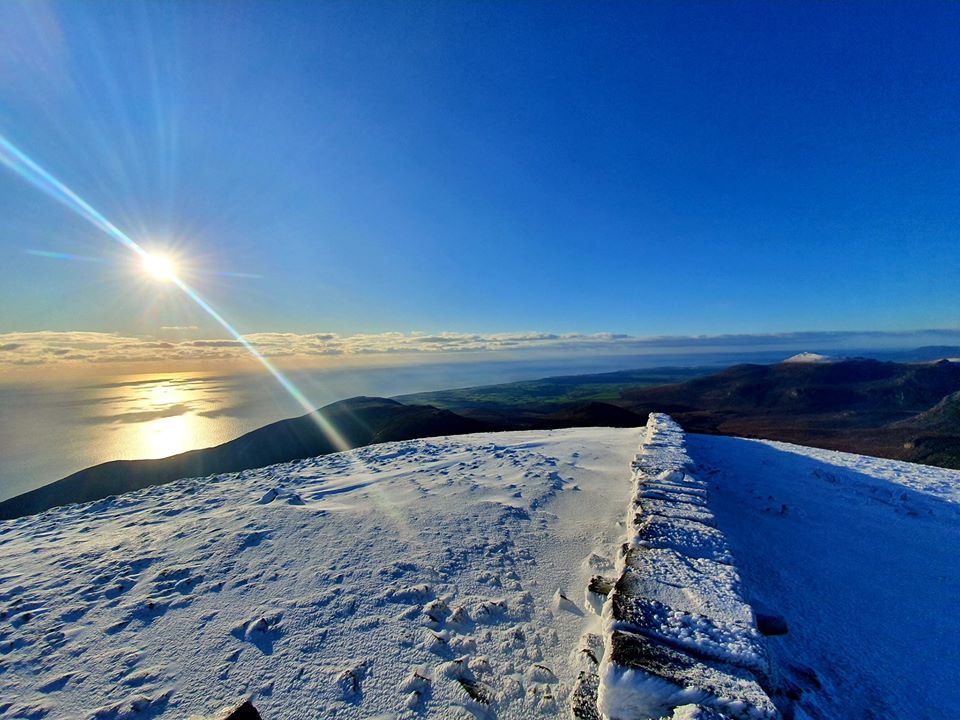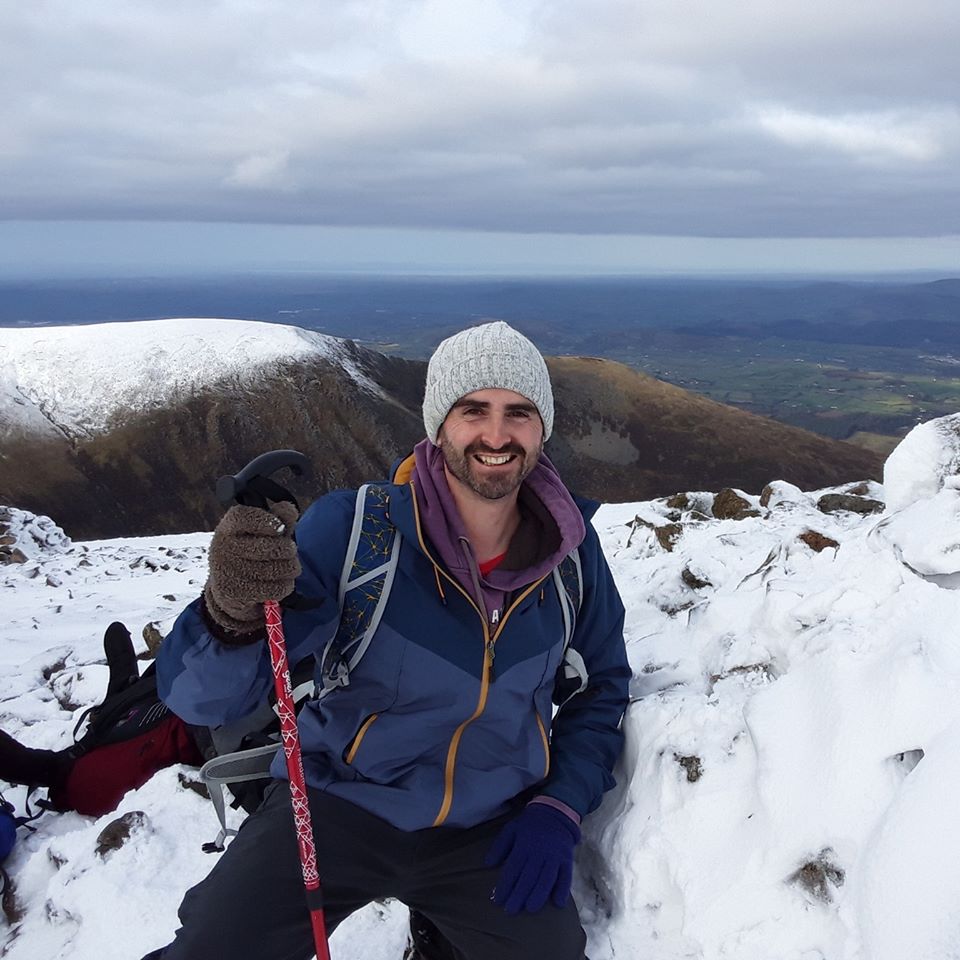Visualizing Your Adventure: Maps and Scenic Views
To make your wild camping experience even more immersive, here are resources and tips on maps and visuals you can use to plan your trip effectively.
Interactive Maps for Wild Camping in Ireland
1. Wicklow Wild Camping Spots Map
Wicklow is one of the most popular locations for wild camping in Ireland. The Wicklow Mountains National Park offers numerous trails and scenic views. Check out the official park map for detailed routes and camping-friendly areas.
Key points to explore:
- Glendalough: With its rich history and two lakes, this spot is ideal for campers who enjoy hiking and photography.
- Lugnaquilla: Perfect for experienced hikers, this area is less crowded and offers tranquility.
2. Wild Camping Spots Map for Northern Ireland
For campers heading north, the Mourne Mountains and the Causeway Coast are not to be missed. Use interactive maps like WalkNI to find trails and nearby wild camping spots.
Highlighted areas:
- Silent Valley Reservoir: A peaceful and scenic spot for an overnight stay.
- Ballintoy: Close to the Causeway Coast, offering coastal views and unique rock formations.
3. Google Maps for Specific Locations
Here’s a quick list of locations you can plug into Google Maps for navigation:
- Knockadav Wild Camping Waterford: A hidden gem with forest trails and open camping spaces.
- Sheep’s Head Peninsula, Cork: Rugged coastal landscapes perfect for campervans or tents.
- Connemara National Park, Galway: A mix of mountains, bogs, and scenic lakes.
Images to Inspire Your Trip
- Wicklow Mountains at Sunrise
Picture the sun rising over the Wicklow Hills, with soft light bathing the valley below—a perfect setting for wild camping.
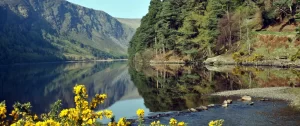
- Slieve League Cliffs, Donegal
Towering cliffs with the sound of crashing waves below—Donegal is a haven for nature lovers.
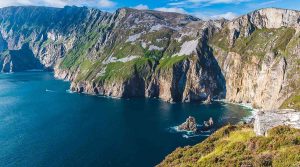
- Connemara Lakes at Sunset
Golden hues reflected on a serene lake, surrounded by bogland and mountains.
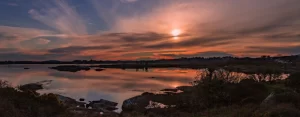
- Wild Campervan Spots
A cozy campervan parked at Achill Island or Ring of Kerry with the Atlantic Ocean in the background.

Packing Checklist for Wild Camping in Ireland
To ensure a successful trip, make sure you pack these essentials:
Camping Gear
- Lightweight tent or campervan essentials
- Sleeping bag (appropriate for Irish weather)
- Ground mat or inflatable mattress
- Camping stove and fuel
- Headlamp or flashlight
Clothing
- Waterproof jacket and pants
- Sturdy hiking boots
- Thermal layers
- Hat and gloves (especially for higher altitudes)
Food and Drink
- Non-perishable food items (dehydrated meals, energy bars)
- Reusable water bottle and water filter
- Cooking utensils and portable stove
Navigation and Safety
- Physical map or GPS device
- Power bank for electronics
- First aid kit
- Emergency whistle
Best Time for Wild Camping in Ireland
While wild camping in Ireland can be done year-round, the summer months (May to September) offer the best weather. However, if you’re looking for solitude and are prepared for unpredictable weather, winter camping can be an adventurous alternative.
Connecting With Local Communities
For a richer experience, consider visiting local pubs, small shops, or cultural festivals near your wild camping destinations. Towns like Dingle, Westport, and Kilkenny offer a mix of Irish hospitality and history.
Responsible Camping: Do Your Part
Wild camping is a privilege, and it’s crucial to protect Ireland’s natural beauty.
- Respect wildlife: Avoid disturbing animals or their habitats.
- Dispose of waste properly: Carry out all your rubbish and avoid leaving food scraps.
- Minimize campfire impact: Use portable stoves instead of open fires in sensitive areas.
Downloadable Resources
- Printable Wild Camping Map (PDF):
Includes Wicklow, Donegal, and Northern Ireland spots with GPS coordinates.
- Image Gallery (JPEG):
A curated set of photos showcasing Ireland’s wild camping highlights.
Your Wild Camping Adventure Awaits
Whether you’re a seasoned camper or a beginner, Ireland’s wild camping spots offer a unique way to connect with nature. From the best wild camping spots in Northern Ireland to the serene beauty of Wicklow wild camping spots, every location has something magical to offer.
Get your gear ready, plan your route with our maps, and start exploring the best of wild camping spots in Ireland. Adventure is calling!
Wild camping in Ireland is an adventure like no other. The Emerald Isle, with its dramatic coastlines, rolling hills, and serene lakes, offers countless opportunities for outdoor enthusiasts to connect with nature. Whether you’re exploring the rugged wilderness of Donegal, the lush landscapes of Wicklow, or the coastal beauty of Cork, there are plenty of wild camping spots in Ireland to discover.
In this guide, we’ll cover everything you need to know about wild camping, including the best places to wild camp in Ireland, tips for camping responsibly, and hidden gems like Knockadav wild camping Waterford and beyond.
What is Wild Camping in Ireland?
Wild camping involves pitching a tent or parking a campervan in a natural, often remote location outside of formal campgrounds. While Ireland does not have a legal “right to roam,” like Scotland, wild camping is generally tolerated as long as you follow Leave No Trace principles and respect local rules.
Why Choose Wild Camping?
- Freedom: Escape the crowds and immerse yourself in Ireland’s untouched beauty.
- Cost: Discover stunning free camping spots in Ireland.
- Adventure: Explore off-the-beaten-path locations and create unforgettable memories.
The Best Wild Camping Spots in Ireland
1. Wild Camping Spots in Wicklow
Wicklow, known as the “Garden of Ireland,” is a haven for outdoor lovers. Its mountains, lakes, and forests make it one of the best wild camping spots in Ireland.
- Wicklow Mountains National Park: Perfect for hikers and nature enthusiasts. Popular areas include Glendalough and Lough Tay.
- Glenmalure Valley: A secluded spot with breathtaking views.
- Wicklow Wild Camping Spots: Explore hidden gems around Lugnaquilla and Lough Dan.
2. Wild Camping Spots in Cork
Cork offers a mix of coastal beauty and rolling countryside. Here are some of the best wild camping spots in Cork:
- Sheep’s Head Peninsula: A quiet and scenic location for wild camping.
- Mizen Head: Wild camp near Ireland’s southernmost point and enjoy dramatic sea views.
- Ballycotton Bay: Perfect for those looking for coastal wild camping sites in Ireland.
3. Wild Camping Spots in Donegal
Donegal’s rugged landscapes and secluded beaches make it ideal for wild camping.
- Horn Head: Camp with panoramic views of the Atlantic Ocean.
- Slieve League Cliffs: One of the highest sea cliffs in Europe, offering awe-inspiring scenery.
- Malin Head: Ireland’s northernmost point, perfect for stargazing and solitude.
4. Wild Camping Spots in Galway
Galway combines culture with stunning natural beauty. Here are some must-visit wild camping spots in Galway:
- Connemara National Park: Pitch your tent amidst breathtaking mountains and boglands.
- Inisheer (Aran Islands): A unique experience for those looking to camp off the mainland.
- Lough Corrib: Enjoy fishing, kayaking, and peaceful camping.
5. Wild Camping Spots in Dublin
Dublin might be known for its vibrant city life, but it also has surprising spots for wild camping.
- Howth Head: A coastal gem just outside the city, offering beautiful views and trails.
- Phoenix Park (Unofficial): While camping is not officially allowed, this large park offers a peaceful escape for day visitors.
6. Wild Camping Spots in Wexford
Wexford’s sunny southeast location is perfect for campers seeking coastal beauty.
- Curracloe Beach: Camp near this famous beach for a mix of relaxation and adventure.
- Hook Peninsula: A historic area with stunning cliffs and plenty of camping opportunities.
- Wild Camping Spots Wexford: Explore hidden areas near Kilmore Quay.
Wild Camping in Northern Ireland
Northern Ireland boasts some of the most dramatic landscapes on the island. Here are the best wild camping spots in Northern Ireland:
- Mourne Mountains: A hiker’s paradise with numerous wild camping opportunities.
- Causeway Coast: Camp near the iconic Giant’s Causeway and enjoy stunning coastal views.
- Lough Erne: Perfect for wild camping and water-based activities.
- Wild Camping Spots Map Northern Ireland: Plan your trip using detailed maps for the most secluded locations.
Hidden Gems: Unique Wild Camping Spots in Ireland
Knockadav Wild Camping Waterford
Located in the southeast, Knockadav is a lesser-known spot for wild camping. With lush green fields and nearby trails, it’s a serene escape for nature lovers.
Wild Campervan Spots in Ireland
If you’re traveling by campervan, Ireland offers numerous scenic locations for overnight stays:
- Achill Island (Mayo): A camper’s dream with beautiful beaches and rugged landscapes.
- Ring of Kerry (Kerry): Park up and enjoy some of Ireland’s most iconic views.
- Wild Campervan Spots Ireland: From coastal pull-ins to mountain laybys, options abound.
Essential Tips for Wild Camping in Ireland
- Follow Leave No Trace Principles: Always clean up after yourself and leave the site as you found it.
- Respect Private Property: Seek permission if camping near farms or private land.
- Stay Safe: Be prepared for changing weather conditions and ensure your gear is adequate.
- Plan Ahead: Use maps to locate the best wild camping spots and avoid overly crowded areas.
Final Thoughts
Ireland’s wild camping opportunities offer something for everyone, from the rugged cliffs of Donegal to the tranquil lakes of Wicklow. Whether you’re exploring free camping spots in Ireland or parking your campervan at scenic locations, this guide provides a starting point for your next adventure.
Start planning your trip, and don’t forget to explore the best wild camping spots in Northern Ireland, Wicklow wild camping spots, and hidden gems like Knockadav Wild Camping Waterford. With this guide, your wild camping journey across Ireland will be an unforgettable experience.
Visualizing Your Adventure: Maps and Scenic Views
To make your wild camping experience even more immersive, here are resources and tips on maps and visuals you can use to plan your trip effectively.
Interactive Maps for Wild Camping in Ireland
1. Wicklow Wild Camping Spots Map
Wicklow is one of the most popular locations for wild camping in Ireland. The Wicklow Mountains National Park offers numerous trails and scenic views. Check out the official park map for detailed routes and camping-friendly areas.
Key points to explore:
- Glendalough: With its rich history and two lakes, this spot is ideal for campers who enjoy hiking and photography.
- Lugnaquilla: Perfect for experienced hikers, this area is less crowded and offers tranquility.
2. Wild Camping Spots Map for Northern Ireland
For campers heading north, the Mourne Mountains and the Causeway Coast are not to be missed. Use interactive maps like WalkNI to find trails and nearby wild camping spots.
Highlighted areas:
- Silent Valley Reservoir: A peaceful and scenic spot for an overnight stay.
- Ballintoy: Close to the Causeway Coast, offering coastal views and unique rock formations.
3. Google Maps for Specific Locations
Here’s a quick list of locations you can plug into Google Maps for navigation:
- Knockadav Wild Camping Waterford: A hidden gem with forest trails and open camping spaces.
- Sheep’s Head Peninsula, Cork: Rugged coastal landscapes perfect for campervans or tents.
- Connemara National Park, Galway: A mix of mountains, bogs, and scenic lakes.
Images to Inspire Your Trip
- Wicklow Mountains at Sunrise
Picture the sun rising over the Wicklow Hills, with soft light bathing the valley below—a perfect setting for wild camping.
(Insert photo of Glendalough Lakes or Lugnaquilla summit)
- Slieve League Cliffs, Donegal
Towering cliffs with the sound of crashing waves below—Donegal is a haven for nature lovers.
(Insert dramatic photo of Slieve League from a cliffside viewpoint)
- Connemara Lakes at Sunset
Golden hues reflected on a serene lake, surrounded by bogland and mountains.
(Insert image of Lough Corrib or Diamond Hill trails)
- Wild Campervan Spots
A cozy campervan parked at Achill Island or Ring of Kerry with the Atlantic Ocean in the background.
(Insert photo of campervan by the beach or on a mountain pass)
Packing Checklist for Wild Camping in Ireland
To ensure a successful trip, make sure you pack these essentials:
Camping Gear
- Lightweight tent or campervan essentials
- Sleeping bag (appropriate for Irish weather)
- Ground mat or inflatable mattress
- Camping stove and fuel
- Headlamp or flashlight
Clothing
- Waterproof jacket and pants
- Sturdy hiking boots
- Thermal layers
- Hat and gloves (especially for higher altitudes)
Food and Drink
- Non-perishable food items (dehydrated meals, energy bars)
- Reusable water bottle and water filter
- Cooking utensils and portable stove
Navigation and Safety
- Physical map or GPS device
- Power bank for electronics
- First aid kit
- Emergency whistle
Best Time for Wild Camping in Ireland
While wild camping in Ireland can be done year-round, the summer months (May to September) offer the best weather. However, if you’re looking for solitude and are prepared for unpredictable weather, winter camping can be an adventurous alternative.
Connecting With Local Communities
For a richer experience, consider visiting local pubs, small shops, or cultural festivals near your wild camping destinations. Towns like Dingle, Westport, and Kilkenny offer a mix of Irish hospitality and history.
Responsible Camping: Do Your Part
Wild camping is a privilege, and it’s crucial to protect Ireland’s natural beauty.
- Respect wildlife: Avoid disturbing animals or their habitats.
- Dispose of waste properly: Carry out all your rubbish and avoid leaving food scraps.
- Minimize campfire impact: Use portable stoves instead of open fires in sensitive areas.
Downloadable Resources
- Printable Wild Camping Map (PDF):
Includes Wicklow, Donegal, and Northern Ireland spots with GPS coordinates.
- Image Gallery (JPEG):
A curated set of photos showcasing Ireland’s wild camping highlights.
Conclusion: Your Wild Camping Adventure Awaits
Whether you’re a seasoned camper or a beginner, Ireland’s wild camping spots offer a unique way to connect with nature. From the best wild camping spots in Northern Ireland to the serene beauty of Wicklow wild camping spots, every location has something magical to offer.
Get your gear ready, plan your route with our maps, and start exploring the best of wild camping spots in Ireland. Adventure is calling!






